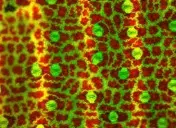 Nanometer is a measurement of length whose symbol is nm . It is a unit equivalent to one billionth of a meter .
Nanometer is a measurement of length whose symbol is nm . It is a unit equivalent to one billionth of a meter .
If we divide 1 meter into 1000 million, therefore, each part obtained is equivalent to 1 nanometer (1 nm). A nanometer is also equal to one millionth of a millimeter .
As you can see, the concept of nanometer is used to refer to very small elements . Its use is frequent in the field of information and communication technologies, for example to refer to the different generations of semiconductors .
Each generation of computer processor presents various improvements with respect to the previous one, such as new instructions, higher performance and a smaller size of the transistor, the most important and smallest part of any electronic device. Since it can present two states, which are usually symbolized by 0 and 1 , the transistor is capable of emulating the basic way in which a bit behaves, allowing or preventing energy from passing through.
With a minimum of one transistor it is possible to create a logic gate to perform low-complexity mathematical operations . With one or more of these logic gates, certain basic operations can be emulated for the management of the instructions of the so-called machine language , the system of codes that the processor can interpret directly.
Thanks to advances in technology, large companies are able to reduce the size of transistors to levels that would have been impossible to imagine in the early days of computing . Every certain number of years, we see that this value in nanometers becomes smaller and smaller: 65, 45, 32, 22, 14... As it becomes smaller, its performance also increases, since it uses less electrical energy to meet the requirements. same tasks.
Transistors are present in a wide range of electronic components beyond microprocessors, although the speed at which their technologies advance can be very different: the race, so to speak, that characterizes the development of CPUs in the computing market. It is far ahead of what other industries can carry out.
In the case of banks, for example, where the information is extremely important and is transmitted through very high-speed private networks, the size of the transistors is usually much smaller than what we can find in a computer store. Let us not forget that the security of our money depends on the processors of these entities.
Between 2004 and 2020, the size of the transistors in processors manufactured by Intel has decreased at a practically constant rate, going from 90 to 5 nanometers , an evolution truly worthy of admiration.
 Nanotechnology , for its part, works with materials that are measured in nanometers. Molecular biology and organic chemistry are two disciplines linked to nanotechnology.
Nanotechnology , for its part, works with materials that are measured in nanometers. Molecular biology and organic chemistry are two disciplines linked to nanotechnology.
Particles measured in nanometers are very important in biology and medicine. The lungs , for example, are known to filter particles of at least two hundred nanometers; If they are smaller, they can move through the body and cause various damages. A person's hair , on the other hand, has a diameter of no more than 80,000 nanometers.
The measurement of wavelengths is also done in nanometers. In this framework, it is relevant to mention that light visible to humans has a wavelength of between approximately 400 and 700 nanometers.
The eye of a subject, therefore, can perceive waves that, in the electromagnetic spectrum, have a length in the mentioned range. If the length is shorter or longer, it is not able to detect the wave.
